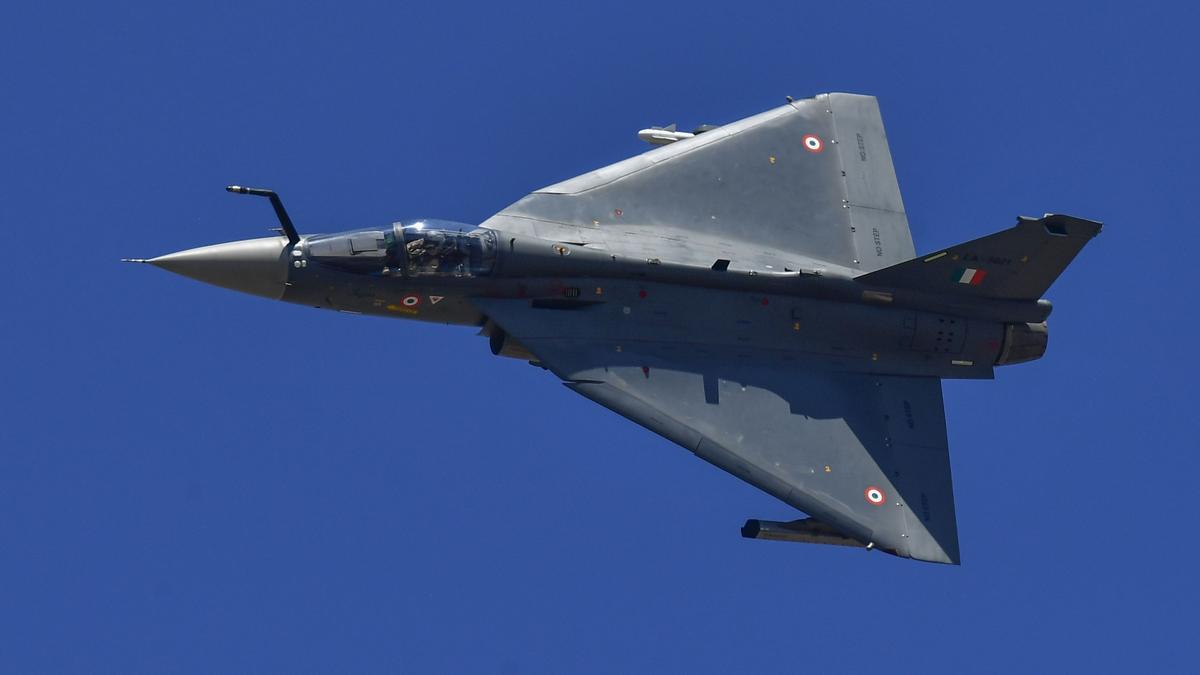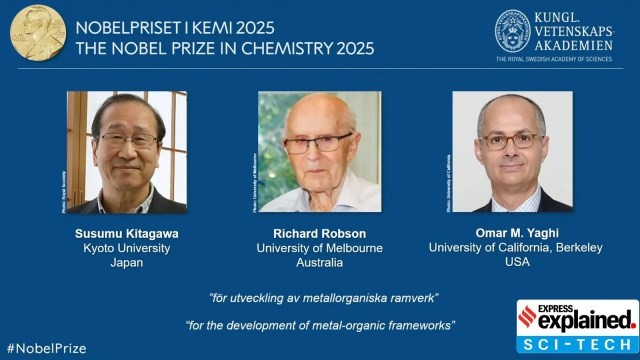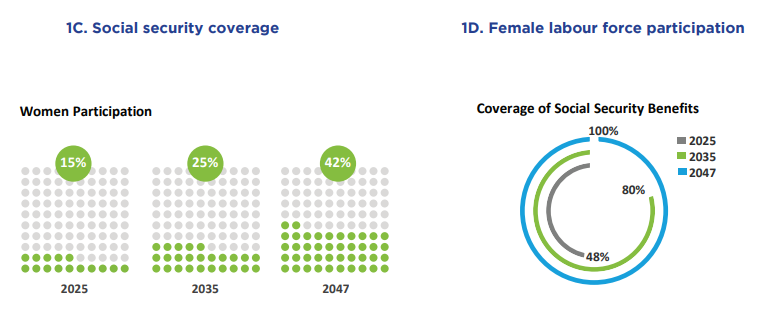IAF to Receive First Tejas Mk1A Fighter Jet

- 11 Oct 2025
In News:
The Indian Air Force (IAF) is set to receive its first Light Combat Aircraft (LCA) Tejas Mk1A by the end of October 2025, marking a major milestone in India’s indigenous defence manufacturing journey under the ‘Atmanirbhar Bharat’ initiative.
Background
- The Tejasprogramme, initiated in 1984 and managed by the Aeronautical Development Agency (ADA) under the Defence Research and Development Organisation (DRDO), was conceived to replace India’s ageing MiG-21 fighter fleet with an indigenously designed and developed multi-role combat aircraft.
- The delivery of the Tejas Mk1A comes under a ?48,000 crore contract signed in 2021 between the Indian Air Force and HAL for 83 aircraft (73 single-seaters and 10 twin-seaters). The production had been delayed primarily due to slow engine deliveries and global supply chain disruptions.
About Tejas Mk1A
The Tejas Mk1A is an upgraded and advanced variant of the baseline Tejas Mk1, designed to enhance combat capability, survivability, and operational maintainability.
Key Upgrades and Capabilities
- Active Electronically Scanned Array (AESA) Radar:Provides superior target detection, tracking, and engagement capability, improving situational awareness and strike precision.
- Electronic Warfare Suite (EWS):Equipped with radar-warning receivers and self-protection jammers, enhancing survivability against enemy radar and missile threats.
- Digital Flight Control Computer (DFCC Mk1A):Improves flight stability, agility, and maneuverability during high-G operations.
- Weapon Compatibility:Supports a wide range of weapons including:
- Beyond Visual Range (BVR) missiles,
- Air-to-Air and Air-to-Ground missiles, and
- Advanced Short-Range Air-to-Air Missiles (ASRAAM).
- Enhanced Avionics and Network Systems:Planned integration of Combined Interrogator and Transponder (CIT), Software Defined Radio (SDR), and Operational Data Link (ODL) for real-time communication and network-centric warfare.
LCA Tejas: Core Features
- Design: Lightest, smallest, and tailless multi-role supersonic fighter in its class.
- Speed: Capable of reaching Mach 1.8.
- Range: Up to 3,000 km.
- Payload Capacity:4,000 kg, supporting precision-guided and conventional munitions.
- Roles: Capable of air superiority, ground attack, and reconnaissance missions.
Variants of the Tejas Family
- Tejas Mk1: Baseline version currently operational with the IAF.
- Tejas Trainer: Twin-seat variant for advanced pilot training and operational conversion.
- LCA Navy: Carrier-capable single- and twin-seat variants for deck operations.
- Tejas Navy Mk2: Phase-II version with enhanced endurance and payload for naval missions.
- Tejas Mk1A: Improved variant with advanced avionics, weapon systems, and network capabilities.
India–Qatar Relations
- 11 Oct 2025
In News:
- The Union Minister of Commerce and Industry, Piyush Goyal, recently visited Doha, Qatar, to co-chair the India–Qatar Joint Commission on Economic and Commercial Cooperation with H.E. Sheikh Faisal bin Thani bin Faisal Al Thani, Qatar’s Minister of Commerce and Industry.
- The visit marked a significant step toward strengthening bilateral economic engagement, deepening energy cooperation, and advancing a future-ready partnership between the two nations.
India–Qatar Joint Commission Meeting: Key Outcomes
- Ambitious Trade Target:Both sides recognised the untapped potential in their economic relationship and set an ambitious goal to double bilateral trade by 2030. Currently, trade between the two nations stands at around USD 14 billion.
- India–Qatar Comprehensive Economic Partnership Agreement (CEPA):The countries reaffirmed their commitment to pursue an ambitious CEPA, a free-trade pact aimed at deepening market access, investment flows, and trade facilitation.
- Digital Integration:A major milestone was the launch of India’s Unified Payments Interface (UPI) in Qatar, enabling seamless digital payments for both the Indian diaspora and Qatari consumers—symbolising the growing digital and fintech cooperation between the two nations.
- Sectoral Cooperation:
The ministers identified multiple sectors for expansion of trade and investment:- Traditional sectors: Pharmaceuticals, textiles, gems &jewellery.
- Manufacturing & technology: Electronics, automobiles, processed foods.
- Future-focused areas: IT, high-tech industries, and renewable energy (especially solar).
- Energy Partnership:India appreciated Qatar’s long-term LNG supply agreement of 7.5 million tonnes per year from 2028, underscoring the centrality of energy security in the bilateral relationship.
Bilateral Trade and Economic Ties
- Trade Profile (FY 2024–25):Bilateral trade stood at USD 14.15 billion, with India facing a trade deficit of about USD 10.78 billion, primarily due to hydrocarbon imports.
- Qatar’s exports to India comprise petroleum and LNG (89% of total trade), while India exports food products, textiles, machinery, and chemicals.
- Investment Linkages:Over 20,000 Indian companies (wholly owned and joint ventures) operate in Qatar, while Qatar’s FDI in India is valued at around USD 1.5 billion, spread across sectors like energy, infrastructure, and technology.
- The Qatar Investment Authority (QIA) has also invested heavily in India’s National Infrastructure Pipeline (NIP), technology start-ups, and real estate.
- Digital and Fintech Cooperation:The introduction of UPI in Qatar represents India’s expanding digital public infrastructure diplomacy, strengthening financial inclusion for over 800,000 Indian residents in Qatar.
Strategic Cooperation Beyond Trade
Energy Security
- Qatar as a Key Supplier:Qatar is India’s largest LNG and LPG supplier, accounting for 26% of India’s LPG imports and over three-fourths of total bilateral trade through hydrocarbons.
- Stability and Clean Transition:Long-term LNG contracts ensure price stability and support India’s clean energy transition under its net-zero goals.
Defence and Security
- The India–Qatar Defence Cooperation Agreement (2008, renewed in 2018) provides a framework for training, naval visits, and joint maritime exercises such as Za’ir-Al-Bahr (Roar of the Sea).
- Regular participation in events like DIMDEX (Doha International Maritime Defence Exhibition) reflects deepening maritime security ties in the Indian Ocean Region.
Cultural and People-to-People Ties
- The 2012 Cultural Cooperation Agreement and the 2019 India–Qatar Year of Culture have promoted cultural exchange through festivals like ‘Passage to India’ (2024).
- The Indian diaspora in Qatar, numbering over 830,000, forms a vital bridge between the two nations, contributing to Qatar’s development and remitting billions annually to India.
Mutual Significance
For India
- Energy Security: Ensures steady LNG supplies and shields India from global price volatility.
- Strategic Investments: QIA’s long-term investments aid infrastructure and industrial growth.
- Diaspora Strength: Provides remittances and strengthens cultural linkages.
- Strategic Depth in West Asia: Qatar’s regional diplomacy and ties with global powers enhance India’s strategic outreach in the Gulf.
For Qatar
- Stable Energy Market: India provides a reliable and growing market for LNG exports, critical for Qatar’s fiscal stability.
- Economic Diversification: India offers investment opportunities beyond hydrocarbons, particularly in fintech, renewables, healthcare, and education.
- Food and Supply Chain Security: India’s exports ensure Qatar’s access to essential commodities and pharmaceuticals.
- Knowledge Partnership: India’s IT, education, and skill development sectors support Qatar’s shift toward a knowledge-based economy under Qatar National Vision 2030.
Broader Vision: Strategic Partnership and Future Outlook
- The visit underscored the elevation of India–Qatar ties to a Strategic Partnership, aligning with India’s vision of becoming a Viksit Bharat by 2047.
Minister Goyal emphasised India’s macroeconomic resilience, robust startup ecosystem, and inclusive growth model, encouraging greater Qatari investments and joint ventures in India’s high-growth sectors. - Both nations agreed to strengthen institutional dialogues, deepen cooperative federalism, and promote business-to-business engagements through platforms such as the India–Qatar Joint Business Council (JBC).
Shram Shakti Niti 2025
- 11 Oct 2025
In News:
The Ministry of Labour and Employment has released the Draft National Labour& Employment Policy – Shram Shakti Niti 2025 for public consultation. This marks India’s first integrated national labour and employment policy, aiming to build a fair, inclusive, and future-ready workforce aligned with the vision of Viksit Bharat @2047.
Objective
- Shram Shakti Niti 2025 seeks to modernise India’s labour ecosystem by ensuring dignity, protection, and opportunity for every worker while responding to emerging challenges such as digital transformation, climate change, and global value chain integration.
- It signals a shift from regulation to facilitation, positioning the Ministry as a proactive employment enabler rather than merely a regulatory authority.
Core Vision and Pillars
The policy is guided by four overarching pillars:
- Dignity of Labour – Ensuring fairness, safety, and equal opportunity.
- Universal Inclusion – Extending benefits to all categories of workers, including informal and gig sectors.
- Cooperative Federalism – Promoting Centre–State coordination and tripartite dialogue among government, employers, and workers.
- Data-Driven Governance – Leveraging digital tools for evidence-based policymaking and transparency.
Seven Strategic Priorities
Shram Shakti Niti 2025 defines seven key focus areas that together shape India’s future of work:
- Universal and Portable Social Security:
- Introduction of a Universal Social Security Account integrating EPFO, ESIC, e-Shram, and PM-JAY, ensuring lifelong and portable coverage.
- Aims to enhance income security and protection for both formal and informal sector workers.
- Occupational Safety and Health:
- Promotes AI-enabled workplace safety systems and health monitoring frameworks.
- Strengthens compliance through digital inspections and risk-based certifications.
- Employment and Future Readiness:
- Builds a resilient, skilled workforce ready for automation, AI, and green transitions.
- Expands digital and vocational skill training to meet the demands of Industry 4.0.
- Women and Youth Empowerment:
- Targets 35% female labour force participation by 2030.
- Encourages flexible work models, childcare support, entrepreneurship, and skill pathways for youth.
- Ease of Compliance and Formalisation:
- Launch of a single-window digital compliance portal with risk-based self-certification to simplify regulations and enhance trust-based governance.
- Technology and Green Transitions:
- Promotes green jobs, sustainable enterprises, and AI-driven workforce management.
- Aligns labour policy with India’s climate and sustainability goals.
- Convergence and Good Governance:
- Establishes a three-tier institutional structure — National, State, and District Labour Missions.
- Introduces a Labour& Employment Policy Evaluation Index (LEPEI) for performance tracking.
- Integrates worker identities, enterprise data, and social security benefits into a unified Labour& Employment Stack.
Digital Public Infrastructure for Employment
A key innovation under Shram Shakti Niti 2025 is the transformation of the National Career Service (NCS) into India’s Employment Digital Public Infrastructure (DPI).
This platform will provide:
- AI-based job matching and credential verification,
- Skill alignment and career guidance, and
- Inclusive access to opportunities across Tier-II and Tier-III cities.
This approach aims to bridge the gap between job seekers, employers, and training institutions through trusted, interoperable digital systems.
Alignment with Labour Reforms
The draft policy complements the consolidation of 29 central labour laws into four Labour Codes:
- Code on Wages, 2019
- Industrial Relations Code, 2020
- Occupational Safety, Health and Working Conditions Code, 2020
- Social Security Code, 2020
Together, these aim to enhance ease of doing business while safeguarding workers’ rights.
Implementation Framework
The policy outlines a phased roadmap (2025–2047):
- Phase I (2025–27): Institutional setup, pilot projects, and digital integration of social security systems.
- Phase II (2027–30): Nationwide rollout of Universal Social Security and AI-driven employment services.
- Phase III (Beyond 2030): Full digital convergence and predictive, data-based labour governance.
Significance
- First comprehensive national labour policy integrating employment, social protection, and technology.
- Enhances labour market efficiency and reduces regulatory fragmentation.
- Ensures inclusive growth by bridging formal–informal divides and empowering women and youth.
- Strengthens cooperative federalism and participatory governance in the world of work.
Nobel Prize in Chemistry 2025

- 11 Oct 2025
In News:
The 2025 Nobel Prize in Chemistry has been awarded to Susumu Kitagawa (Japan), Richard Robson (Australia), and Omar Yaghi (Jordan–USA) for their pioneering work in developing Metal–Organic Frameworks (MOFs) — a novel class of crystalline materials with exceptional porosity and tunable chemical properties. Their innovation has transformed the field of materials chemistry, enabling new solutions for energy, environment, and sustainability.
About the Nobel Prize in Chemistry
Instituted under the 1895 will of Alfred Nobel, the Nobel Prize in Chemistry honours individuals whose discoveries have profoundly advanced the chemical sciences and benefitted humanity. The 2025 award acknowledges a transformative leap in reticular chemistry — the design and synthesis of porous networks using metal ions and organic linkers.
Genesis of Metal–Organic Frameworks (MOFs)
In most materials, atoms are tightly packed, leaving little internal space. The Nobel laureates devised a way to link metal atoms with organic molecules in an open, lattice-like structure that leaves large, orderly cavities — creating materials capable of trapping, storing, or releasing other molecules with precision.
- Richard Robson, in the 1970s at the University of Melbourne, first envisioned connecting atoms through molecular linkers to create spacious molecular architectures.
- Susumu Kitagawa in the 1990s demonstrated that such frameworks could be flexible, “breathing” materials capable of absorbing and releasing gases.
- Omar Yaghi, from the 2000s onwards, stabilised these frameworks and founded reticular chemistry, systematically designing MOFs for targeted purposes such as carbon capture, water harvesting, and gas storage.
What are MOFs?
Metal–Organic Frameworks (MOFs) are hybrid crystalline materials formed by coordinating metal ions or clusters (e.g., copper, zinc, aluminium) with organic ligands to produce rigid, porous 3D networks.
These frameworks function like atomic sponges, capable of holding, filtering, or releasing molecules with high selectivity. Each gram of a MOF can offer a surface area equivalent to several football fields, allowing immense storage capacity.
Key Properties of MOFs
- Super Porosity:Exceptionally high internal surface area, enabling efficient molecular capture and storage.
- Customisability:The pore size, shape, and chemical affinity can be precisely engineered to trap specific molecules — for example, CO? or methane.
- Breathing Flexibility:Some MOFs expand or contract in response to absorbed gases, similar to a lung inhaling and exhaling.
- Chemical Stability:MOFs are robust, reusable, and resistant to heat and chemical degradation.
- Eco-Friendly Synthesis:They can be produced via low-cost, green methods, enhancing scalability and industrial applicability.
Applications and Global Relevance
- Climate Action – Carbon Capture:MOFs can selectively absorb carbon dioxide (CO?) from industrial emissions or the atmosphere, aiding climate mitigation strategies.
- Water Harvesting:Certain MOFs extract water vapour from arid air — a potential lifeline for water-scarce regions.
- Clean Energy Transition:Their ability to store hydrogen or methane makes MOFs promising materials for next-generation, lightweight, and safe fuel systems.
- Environmental Remediation:MOFs can trap and remove pollutants such as PFAS, heavy metals, and toxic gases, supporting cleaner air and water.
- Biomedical and Catalytic Uses:In pharmaceuticals and industrial chemistry, MOFs act as catalysts or as carriers for targeted drug delivery.
NITI Aayog report “Roadmap on AI for Inclusive Societal Development”

- 11 Oct 2025
In News:
NITI Aayog has unveiled its strategic report “Roadmap on AI for Inclusive Societal Development”, which presents a comprehensive vision for leveraging Artificial Intelligence (AI) to strengthen India’s vast informal economy through enhanced digital inclusion, skilling, and social protection systems.
Status of India’s Informal Workforce
- Scale and Economic Role: Approximately 490 million Indians—about 90% of the national workforce—are engaged in informal employment spanning agriculture, construction, and services, together contributing nearly half of India’s GDP (MoLE, 2024).
- Rural Dominance: Over 80% of rural labourers operate without written contracts or social security coverage, especially in construction, handicrafts, and retail sectors.
- Gendered Vulnerability: Women constitute around 55% of the informal workforce, with significant representation in home-based and agricultural activities (ILO, 2023).
- Low Productivity and Earnings: Informal sector productivity remains roughly one-fourth that of the formal economy, perpetuating low wages and economic insecurity.
- Emergence of Urban Informality: The gig and platform economy has created a new informal class, with nearly 7.5 million platform workers (NITI Aayog, 2022) still outside formal labour protections.
Core Challenges
- Financial Instability: Over three-fourths of informal workers earn below ?10,000 per month and face limited access to affordable credit or insurance (PLFS, 2024).
- Market Inefficiencies: Only about 12% of small producers or artisans access digital or organized markets directly, remaining dependent on intermediaries.
- Digital and Skill Divide: Around 70% of informal workers lack basic digital literacy, impeding their participation in AI-integrated economies.
- Weak Social Protection: Just one-third of eligible informal workers are registered under welfare schemes such as e-Shram or PM-SYM.
- Policy Fragmentation: Overlapping databases and weak institutional coordination hinder effective benefit delivery and erode worker trust.
Transformative Potential of AI
- Financial Empowerment: AI-based credit assessment tools (e.g., SBI YONO, Setu.ai) can facilitate microloans for workers lacking traditional financial records.
- Digital Public Infrastructure (DPI): Platforms such as Aadhaar, UPI, and e-Shram can establish verifiable worker identities, improving transparency in wage payments and welfare targeting.
- Smart Contracts and Blockchain: Use of blockchain for wage traceability and supply chain verification (e.g., Tata Steel Foundation’s pilot in Jharkhand) can curb exploitation.
- AI-driven Skilling: Adaptive learning ecosystems like Skill India Digital can deliver personalized, voice-enabled vernacular micro-courses for re-skilling informal workers.
- Predictive Governance: AI-based data analytics can enhance targeting and timeliness of welfare delivery (e.g., integration with PM-Kisan data systems).
Major Recommendations
- Launch of ‘Digital ShramSetu Mission’: Create an AI-enabled national platform integrating social security, skilling, and livelihood databases for informal workers.
- Sector-specific AI Models: Focus on high-impact areas—agriculture, construction, logistics, and retail—for productivity enhancement.
- Inclusive Design: Develop voice-first, multilingual AI interfaces to ensure accessibility for low-literacy populations.
- Public–Private Collaboration: Promote partnerships among government agencies, startups, and tech firms for scalable innovation in informal ecosystems.
- Responsible AI Charter: Establish a framework ensuring transparency, privacy, and inclusivity in AI deployment for social sectors.
- AI-based Skilling Framework: Institutionalize micro-credential courses and continuous re-skilling under Skill India 2.0.
- Impact Evaluation Mechanism: Implement real-time data-driven monitoring to assess inclusion, income enhancement, and service delivery outcomes.
